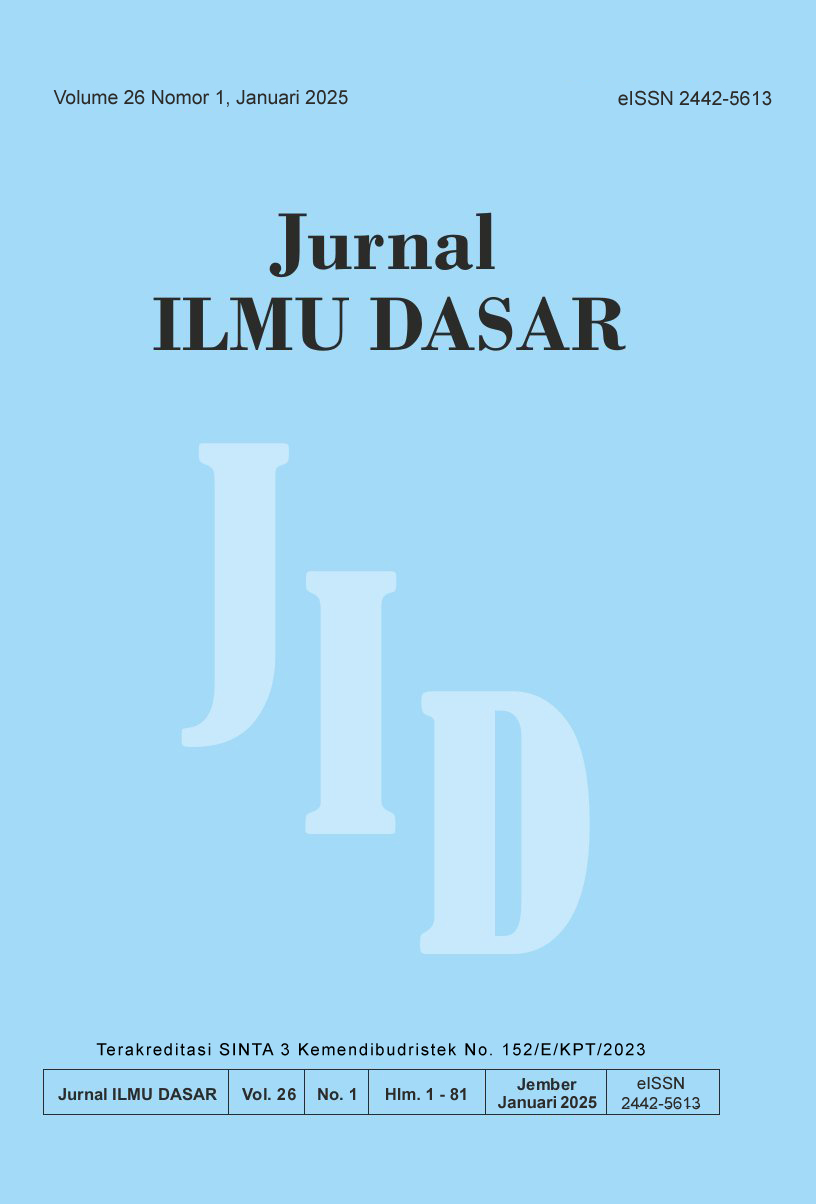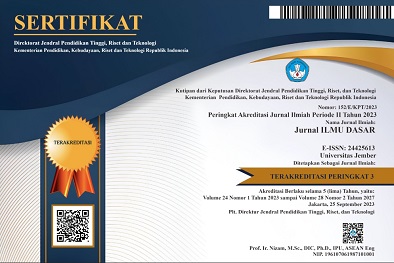Interleukin-6 as an Indicator for Acute Toxicity of DBL2β-PfEMP1 Recombinant protein as a Peptide-based Malaria Vaccine Candidate
DOI:
https://doi.org/10.19184/jid.v26i1.4612Keywords:
adaptive immunity, DBL 2 β - PfEMP1, malaria pathogenesis peptide - based malaria vaccine, recombinant proteinAbstract
Malaria caused by Plasmodium spp is an important health problem, and vaccination could be essential for disease prevention. One potential protein candidate is the Duffy binding-like 2β (DBL2β)-Plasmodium falciparum erythrocyte membrane protein 1 (PfEMP1). The protein is responsible for malaria pathogenesis by mediating binding to intercellular adhesion molecule-1 (ICAM-1), a receptor on the host cells. This study aimed to investigate the acute toxicity of the DBL2β-PfEMP1 recombinant protein as a basis for developing a peptide-based malaria vaccine based on body weight and interleukin-6 (IL-6) concentration. The study used male and female Wistar rats, which were divided into treatment and control groups after two weeks of acclimatization. Rats in the treatment group were injected with 750 µg DBL2β-PfEMP1 recombinant protein, and the control group was injected with NaCl 0.9%. Any indications of clinical toxicity symptoms were closely monitored within 4 hours of injection up to 24 hours. Observations were conducted daily for 14 days and included body weight and toxicity symptoms such as rising fur, tremors, salivation, diarrhea, weakness, draping, excitability, twitching, and death. Blood was collected on days 5, 7, and 14 for IL-6 examination using the ELISA method. Rats were euthanized on day 14. Data were analyzed using an ANOVA test. There was no significant weight loss as well as weight gain and toxicity symptoms during 14 days after treatment in all groups. There was an increase IL-6 levels on day 14 in all groups. However, statistical analysis did not show a significant difference between the control and treatment groups (p>0.05). This study showed that the DBL2β-PfEMP1 recombinant protein has no acute toxicity in Wistar rats, implying its safety and potential as a peptide-based malaria vaccine.
References
Chan, J.-A., Fowkes, F. J. I., & Beeson, J. G. (2014). Surface antigens of Plasmodium falciparum-infected erythrocytes as immune targets and malaria vaccine candidates. Cellular and Molecular Life Sciences, 71(19), 3633-3657.
Ghasemi, A., Sajad, J., Kashfi. K. (2021). Review article : The laboratory rat: age and body weight matter. EXCLI Journal 2021;20:1431-1445, 2005, 1431-1445.
Gullingsrud, J., Saveria, T., Amos, E., Duffy, P. E., & Oleinikov, A. V. (2013). Structure-Function-Immunogenicity Studies of PfEMP1 Domain DBL2βPF11_0521, a Malaria Parasite Ligand for ICAM-1. PLoS ONE, 8(4), 1–8. https://doi.org/10.1371/journal.pone.0061323
Hamilton, F., Mitchell, R. E., Constantinescu, A., Hughes, D., Cunnington, A., Ghazal, P., & Timpson, N. J. (2023). The effect of interleukin-6 signaling on severe malaria: A Mendelian randomization analysis. International Journal of Infectious Diseases, 129, 251-259. https://doi.org/10.1016/j.ijid.2023.02.008
Hviid, L. (2010). The role of Plasmodium falciparum variant surface antigens in protective immunity and vaccine development. Human Vaccines, 6(1), 84–89. https://doi.org/10.4161/hv.6.1.9602
Kemenkes, R. (2022). Rencana Kerja Tahunan Direktorat Jenderal Tenaga Kesehatan 2022. In Direktorat Jenderal Tenaga Kesehatan Kementrian Kesehatan Republik Indonesia (Vol. 1, Issue 2).
Lyke, K. E., Burges, R., Cissoko, Y., Sangare, L., Dao, M., Diarra, I., Kone, A., Harley, R., Plowe, C. V., Doumbo, O. K., & Sztein, M. B. (2004). Serum levels of the proinflammatory cytokines interleukin-1 beta (IL-1β), IL-6, IL-8, IL-10, tumor necrosis factor alpha, and IL-12(p70) in Malian children with severe Plasmodium falciparum malaria and matched uncomplicated malaria or healthy controls. Infection and Immunity, 72(10), 5630-5637. https://doi.org/10.1128/IAI.72.10.5630-5637.2004
Mandala, W. L., Msefula, C. L., Gondwe, E. N., Drayson, M. T., Molyneux, M. E., & MacLennan, C. A. (2017). Cytokine Profiles in Malawian Children Presenting with Uncomplicated Malaria, Severe Malarial Anemia, and Cerebral
Malaria. Clinical and Vaccine Immunology : CVI, 24(4). https://doi.org/10.1128/CVI.00533-16
McQuaid, F., & Rowe, J. A. (2020). Rosetting revisited: A critical look at the evidence for host erythrocyte receptors in Plasmodium falciparum rosetting. Parasitology, 147(1), 1-11. https://doi.org/10.1017/S0031182019001288
Ndam, N., & Moussiliou, A. (2017). Parasites Causing Cerebral Falciparum Malaria Bind Multiple Endothelial Receptors and Express EPCR and ICAM-1-Binding PfEMP1. Journal of Infectious Diseases, 215(12), 1918-1925. https://doi.org/10.1093/infdis/jix230
Olsen, R. W., Ecklu-mensah, G., Bengtsson, A., Ofori, M. F., Kusi, K. A., & Koram, K. A. (2019). crossm Plasmodium falciparum Erythrocyte Membrane Protein 1. 87(10), 1-13.
Perera, M. K., Herath, N. P., Pathirana, S. L., Phone-Kyaw, M., Alles, H. K., Mendis, K. N., Premawansa, S., & Handunnetti, S. M. (2013). Association of high plasma TNF-alpha levels and TNF-alpha/IL-10 ratios with TNF2 allele in severe P. falciparum malaria patients in Sri lanka. Pathogens and Global Health, 107(1), 21–29. https://doi.org/10.1179/2047773212Y.0000000069
Rachmania, S., Sulistyaningsih, E., Agung, A., Ratnadewi, I., & Dewi, R. (2020). Epitopes prediction of PfEMP1-DBL2? recombinant protein from Indonesian Plasmodium falciparum Isolate for malaria vaccine development. Medico-Legal Update, 20(4), 541-549. https://doi.org/10.37506/mlu.v20i4.1874
Rachmania, S., Sulistyaningsih, E., & Ratna Dewi, A. A. I. (2021). Recombinant DBL2β-PfEMP1 of the Indonesian Plasmodium falciparum induces immune responses in Wistar rats. Journal of Taibah University Medical Sciences, 16(3), 422-430. https://doi.org/10.1016/j.jtumed.2020.12.007
Rowe, J. A., Claessens, A., Corrigan, R. A., & Arman, M. (2009). Adhesion of Plasmodium falciparum-infected erythrocytes to human cells: Molecular mechanisms and therapeutic implications. Expert Reviews in Molecular Medicine, 11(May), 1-29. https://doi.org/10.1017/S1462399409001082
Sulistyaningsih, E., Hidayah, F., & Prasetyo, A. (2018). Cloning and protein structure prediction of DBL2β-pfEMP1 recombinant protein from Indonesian Plasmodium falciparum isolate. Current Topics in Peptide and Protein Research, 19, 75-79.
Tanaka, T., Narazaki, M., & Kishimoto, T. (2014). IL-6 in inflammation, immunity, and disease. Cold Spring Harbor Perspectives in Biology, 6(10), a016295. https://doi.org/10.1101/cshperspect.a016295
Tessema, S. K., Nakajima, R., Jasinskas, A., Monk, S. L., Lekieffre, L., Lin, E., Kiniboro, B., Proietti, C., Siba, P., Felgner, P. L., Doolan, D. L., Mueller, I., & Barry, A. E. (2019). Protective Immunity against Severe Malaria in Children Is Associated with a Limited Repertoire of Antibodies to Conserved PfEMP1 Variants. Cell Host and Microbe, 26(5), 579-590.e5. https://doi.org/10.1016/j.chom.2019.10.012
Turner, L., Lavstsen, T., Berger, S. S., Wang, C. W., Petersen, J. E. V., Avril, M., Brazier, A. J., Freeth, J., Jespersen, J. S., Nielsen, M. A., Magistrado, P., Lusingu, J., Smith, J. D., Higgins, M. K., & Theander, T. G. (2013). Severe malaria is associated with parasite binding to endothelial protein C receptor. Nature, 498(7455), 502–505. https://doi.org/10.1038/nature12216
WHO. (2018). Indonesia South-East Asia Region - Malaria Profile. https://www.who.int/malaria/publications/country-profiles/profile_idn_en.pdf?ua=1
WHO. (2023). World malaria World malaria report report.
Wilairatana, P., Mala, W., Milanez, G. D. J., Masangkay, F. R., Kotepui, K. U., & Kotepui, M. (2022). Increased interleukin-6 levels associated with malaria infection and disease severity: a systematic review and meta-analysis. Scientific Reports, 12(1), 1-24. https://doi.org/10.1038/s41598-022-09848-9
Wiser, M. F. (2023). Knobs, Adhesion, and Severe Falciparum Malaria. Tropical Medicine and Infectious Disease, 8(7). https://doi.org/10.3390/tropicalmed8070353








